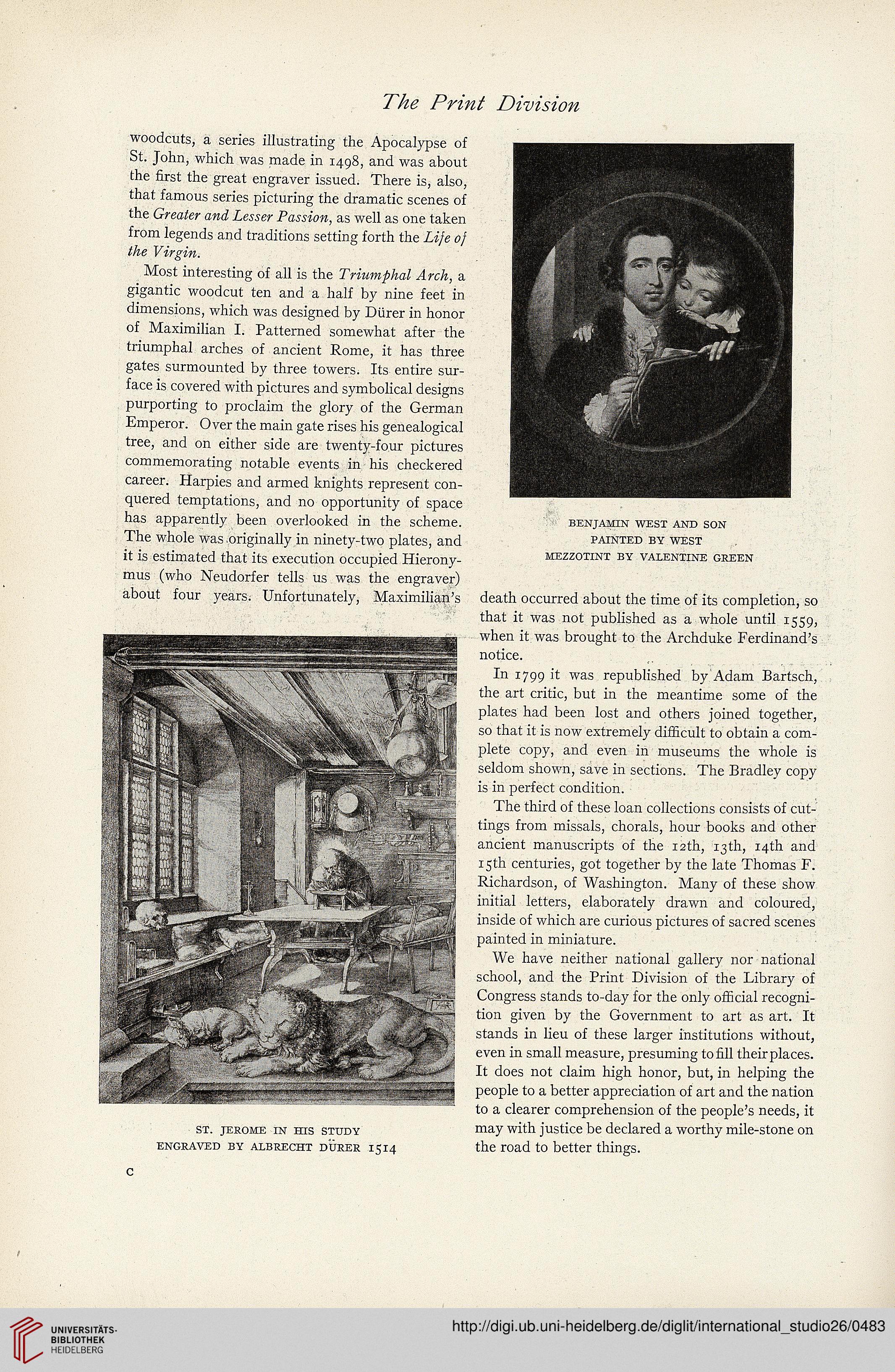71%<? /W72/
woodcuts, a series illustrating the Apocalypse of
St. John, which was made in 1498, and was about
the first the great engraver issued. There is, also,
that famous series picturing the dramatic scenes of
the Greater awd Zejjer Tayjfow, as well as one taken
from legends and traditions setting forth the Zf/e a/
fAe Tfrgw.
Most interesting of all is the ZHMW^Auf 4DcA, a
gigantic woodcut ten and a half by nine feet in
dimensions, which was designed by Durer in honor
of Maximilian 1. Patterned somewhat after the
triumphal arches of ancient Rome, it has three
gates surmounted by three towers. Its entire sur-
face is covered with pictures and symbolical designs
purporting to proclaim the glory of the German
Emperor. Over the main gate rises his genealogical
tree, and on either side are twenty-four pictures
commemorating notable events in his checkered
career. Harpies and armed knights represent con-
quered temptations, and no opportunity of space
has apparently been overlooked in the scheme.
The whole was originally in ninety-two plates, and
it is estimated that its execution occupied Hierony-
mus (who Neudorfer tells us was the engraver)
about four years. Unfortunately, Maximilian's
ST. JEROME IN HIS STUDY
ENGRAVED BY ALBRECHT DURER 1514
BENJAMIN WEST AND SON
PAINTED BY WEST
MEZZOTINT BY VALENTINE GREEN
death occurred about the time of its completion, so
that it was not published as a whole until 1559,
when it was brought to the Archduke Ferdinand's
notice.
In 1799 it was republished by Adam Bartsch,
the art critic, but in the meantime some of the
plates had been lost and others joined together,
so that it is now extremely difficult to obtain a com-
plete copy, and even in museums the whole is
seldom shown, save in sections. The Bradley copy
is in perfect condition.
The third of these loan collections consists of cut-
tings from missals, chorals, hour books and other
ancient manuscripts of the 12th, 13th, 14th and
15th centuries, got together by the late Thomas F.
Richardson, of Washington. Many of these show
initial letters, elaborately drawn and coloured,
inside of which are curious pictures of sacred scenes
painted in miniature.
We have neither national gallery nor national
school, and the Print Division of the Library of
Congress stands to-day for the only official recogni-
tion given by the Government to art as art. It
stands in lieu of these larger institutions without,
even in small measure, presuming to fill their places.
It does not claim high honor, but, in helping the
people to a better appreciation of art and the nation
to a clearer comprehension of the people's needs, it
may with justice be declared a worthy mile-stone on
the road to better things.
c
woodcuts, a series illustrating the Apocalypse of
St. John, which was made in 1498, and was about
the first the great engraver issued. There is, also,
that famous series picturing the dramatic scenes of
the Greater awd Zejjer Tayjfow, as well as one taken
from legends and traditions setting forth the Zf/e a/
fAe Tfrgw.
Most interesting of all is the ZHMW^Auf 4DcA, a
gigantic woodcut ten and a half by nine feet in
dimensions, which was designed by Durer in honor
of Maximilian 1. Patterned somewhat after the
triumphal arches of ancient Rome, it has three
gates surmounted by three towers. Its entire sur-
face is covered with pictures and symbolical designs
purporting to proclaim the glory of the German
Emperor. Over the main gate rises his genealogical
tree, and on either side are twenty-four pictures
commemorating notable events in his checkered
career. Harpies and armed knights represent con-
quered temptations, and no opportunity of space
has apparently been overlooked in the scheme.
The whole was originally in ninety-two plates, and
it is estimated that its execution occupied Hierony-
mus (who Neudorfer tells us was the engraver)
about four years. Unfortunately, Maximilian's
ST. JEROME IN HIS STUDY
ENGRAVED BY ALBRECHT DURER 1514
BENJAMIN WEST AND SON
PAINTED BY WEST
MEZZOTINT BY VALENTINE GREEN
death occurred about the time of its completion, so
that it was not published as a whole until 1559,
when it was brought to the Archduke Ferdinand's
notice.
In 1799 it was republished by Adam Bartsch,
the art critic, but in the meantime some of the
plates had been lost and others joined together,
so that it is now extremely difficult to obtain a com-
plete copy, and even in museums the whole is
seldom shown, save in sections. The Bradley copy
is in perfect condition.
The third of these loan collections consists of cut-
tings from missals, chorals, hour books and other
ancient manuscripts of the 12th, 13th, 14th and
15th centuries, got together by the late Thomas F.
Richardson, of Washington. Many of these show
initial letters, elaborately drawn and coloured,
inside of which are curious pictures of sacred scenes
painted in miniature.
We have neither national gallery nor national
school, and the Print Division of the Library of
Congress stands to-day for the only official recogni-
tion given by the Government to art as art. It
stands in lieu of these larger institutions without,
even in small measure, presuming to fill their places.
It does not claim high honor, but, in helping the
people to a better appreciation of art and the nation
to a clearer comprehension of the people's needs, it
may with justice be declared a worthy mile-stone on
the road to better things.
c




